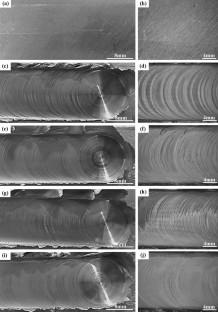Journal of Thermal Spray Technology ( IF 3.1 ) Pub Date : 2022-05-09 , DOI: 10.1007/s11666-022-01369-1 Gang Ji 1 , Hong Liu 1 , Guan-Jun Yang 1 , Xiao-Tao Luo 1 , Cheng-Xin Li 1 , Yu-Feng Sun 2 , Shu-Hao Zhu 2 , Chen Zhao 2

|
In this study, cold spraying was introduced to produce an Al deposit on a Cu substrate, which was then modified through a solid-state method named friction-stir-processing (FSP). The pores and inter-particle interfaces within the Al deposit completely disappeared after FSP at traverse speeds less than 18 mm/min. Equiaxed grains containing a low density of dislocations occurred in the Al deposit after FSP. The grain size increased, while the dislocation density decreased with decreasing traverse speed. Meanwhile, three intermetallic compound (IMC) layers including Al2Cu, AlCu, and Al4Cu9 were developed at the Al/Cu interface after FSP. The thickness of the entire IMC layers and the continuity of the AlCu layer increased as the traverse speed was reduced. Due to the generation of the IMC layers, the adhesion strength of the deposit dramatically improved after FSP. The variation of the adhesion strength after FSP at different traverse speeds was associated with the continuity of the AlCu layer. The electrical conductivity of the Al deposit was remarkably enhanced after FSP due to the disappearance of pores and inter-particle interfaces. Furthermore, the changes in the electrical conductivity of the Al deposit and Al-Cu bimetallic structure after FSP at different traverse speeds were related to the number of grain boundaries and the thickness of IMC layers, respectively.
中文翻译:

通过摩擦-搅拌处理提高铜基板上冷喷涂铝镀层的粘附强度和导电性
在这项研究中,引入冷喷涂以在铜基板上产生铝沉积物,然后通过称为摩擦搅拌处理 (FSP) 的固态方法对其进行改性。在横向速度小于 18 mm/min 的 FSP 后,Al 沉积物中的孔隙和颗粒间界面完全消失。FSP 后,Al 沉积物中出现了含有低密度位错的等轴晶粒。晶粒尺寸增加,而位错密度随着横向速度的降低而降低。同时,三个金属间化合物 (IMC) 层包括 Al 2 Cu、AlCu 和 Al 4 Cu 9在 FSP 之后在 Al/Cu 界面开发。整个IMC层的厚度和AlCu层的连续性随着移动速度的降低而增加。由于 IMC 层的产生,FSP 后沉积物的粘附强度显着提高。FSP后不同移动速度下粘合强度的变化与AlCu层的连续性有关。由于孔隙和颗粒间界面的消失,FSP 后 Al 沉积物的电导率显着增强。此外,不同移动速度下 FSP 后 Al 沉积层和 Al-Cu 双金属结构的电导率变化分别与晶界数量和 IMC 层厚度有关。


























 京公网安备 11010802027423号
京公网安备 11010802027423号